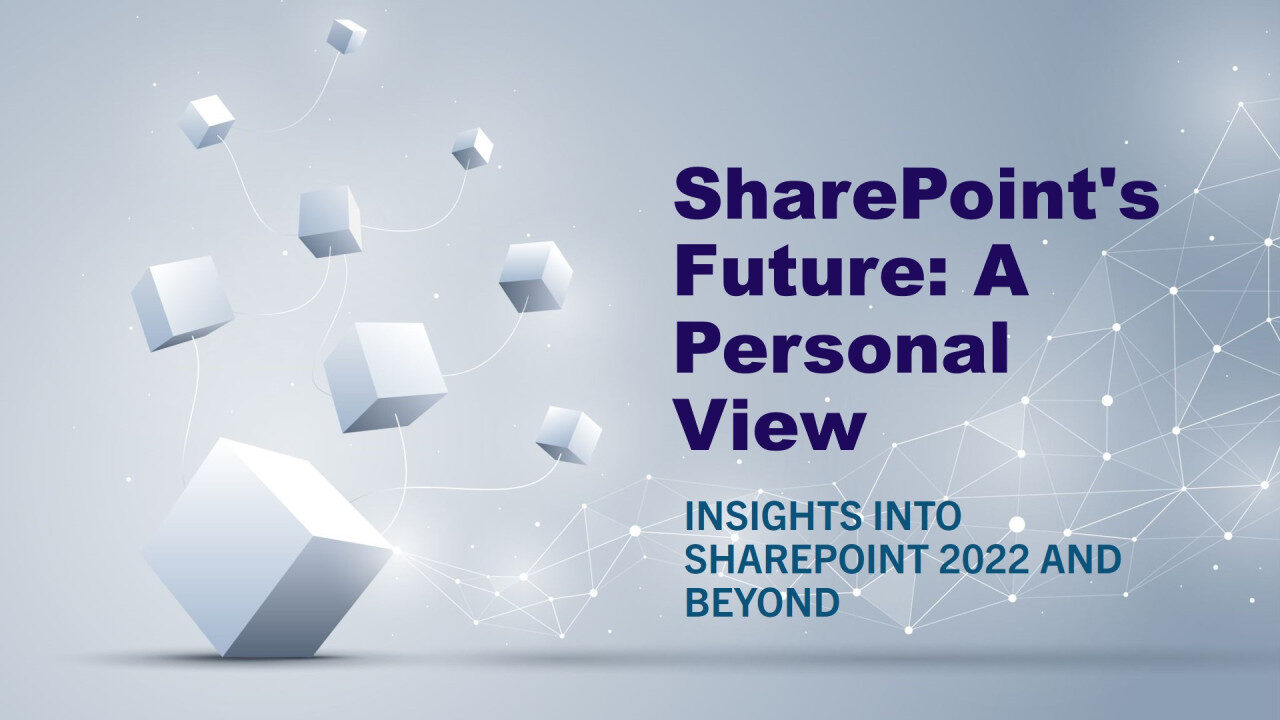As I write the final three articles in my continuing #30YearsInIT series, I arrive at a crucial point for many organisations still invested in on-premises infrastructure and solutions – SharePoint On-Premises. While much of the focus today is on the cloud and how it empowers modern workplaces, SharePoint’s on-premises versions continue to evolve, meeting the unique needs of businesses that require greater control over their infrastructure. This post takes a look at SharePoint 2022 SE, previews the upcoming SharePoint 2025?(not officially named by Microsoft at the time of writing), and speculates on what the future may hold for SharePoint on-premises.
SharePoint 2022 SE: The Subscription Edition
The current latest version, SharePoint Server 2022 Subscription Edition (SE), represents a shift in the framework of how Microsoft approaches on-premises SharePoint deployments. Moving away from major version upgrades every year, the Subscription Edition focuses on continuous updates that ensure the product remains current without requiring complete overhauls every few years. This shift means that on-premises users can enjoy modern features similar to those in SharePoint Online but with the flexibility of managing everything locally. Key features introduced in SharePoint 2022 SE include:
- Support for Modern Development: SharePoint SE introduces support for SharePoint Framework (SPFx) 1.5.1, which enhances customisation scenarios, allowing developers to use modern web technologies to build responsive applications and productive experiences. The integration of SPFx means that developers working in on-premises environments now have access to a set of tools and methodologies previously reserved for SharePoint Online, enabling more modern, interactive features to enhance user engagement.
- Granular Security Enhancements: There’s also improved private key management for certificates, ensuring robust security, and native support for TLS 1.3, offering the latest in secure communication between systems. Antimalware Scan Interface (AMSI) integration also represents a critical addition to protect against evolving cyber threats. AMSI allows for deep integration with on-server antimalware tools, ensuring that SharePoint deployments are protected against potentially malicious requests.
- Infrastructure Modernisation: Recompiled with Visual C++ 2022, SharePoint 2022 SE is now built on a modern development stack, making it capable of taking advantage of the latest server hardware improvements, boosting performance and reliability in enterprise environments. This modernisation is crucial in improving compatibility with newer versions of Windows Server, specifically Windows Server 2022, which ensures enhanced stability and performance.
- User Experience and Productivity Improvements: The modern document libraries and lists introduced in SharePoint 2022 SE offer a streamlined and user-friendly experience, akin to what users are familiar with in SharePoint Online. These modern libraries come with features like bulk editing, improved copy and move capabilities, and column formatting enhancements, allowing for better data visualisation and interaction. Button web parts now make it easier for users to create actionable pages, improving intranet usability for business teams.
- Hybrid Flexibility: SharePoint 2022 SE has also enhanced hybrid connectivity capabilities. Organisations that want to bridge their on-premises environment with the cloud can take advantage of improved hybrid search, which allows data from both on-premises and cloud-based SharePoint environments to be searchable from one unified search experience.
The continuous update model of SharePoint 2022 SE means that new features are released twice a year, bringing predictability to feature rollouts. These feature updates are also bundled into monthly public updates that include security and quality enhancements, ensuring organisations remain secure while having access to the latest productivity tools.
SharePoint 2025: Looking Ahead – A Personal Opinion
Microsoft has made no official announcements regarding SharePoint 2025 (Not sure if it will even release at this time), but if the recent progression (and existing 3 year release schedules) is any indicator, we will likely see further alignment with the Microsoft 365 ecosystem due to the constant frequency of updates made to the cloud. SharePoint 2025 may continue the trend of building on the Subscription Edition, incorporating further advancements such as:
- Deeper Integration with Cloud Services: As hybrid models become more understandable and useable, future on-premises versions could make hybrid deployments more seamless. For instance, better integration with Power Platform services such as Power Automate for workflows might enable businesses to bridge on-premises data with cloud automation services. By leveraging the Power Platform, organisations could create sophisticated workflows that include both on-premises and cloud-stored (and accessible) data, ensuring efficient data processing and business logic management across environments.
- AI and Machine Learning on Premises: Leveraging AI capabilities seen in Microsoft 365, SharePoint 2025 could potentially introduce on-premises AI capabilities for enhanced search, document classification, and automated metadata tagging, giving on-premises users some of the power that SharePoint Online users enjoy. With AI and machine learning, on-premises environments could benefit from advanced content organisation, helping users find information faster and reducing the overhead involved in managing large volumes of documents.
- Improved Collaboration Features: Expect improvements to hybrid collaboration tools, further integration with Microsoft Teams, and enhanced real-time co-authoring capabilities, even in environments with limited external connectivity. SharePoint 2025 may also push for better integration with Microsoft’s suite of collaboration tools, making it possible for on-premises users to interact seamlessly with cloud users within the same Teams and SharePoint channels.
- Expanded Hybrid Search Capabilities: Microsoft could expand hybrid search capabilities to allow even more seamless interaction between on-premises and cloud environments. This might include new ways of indexing and searching content stored on different systems, providing a unified interface to users irrespective of where data resides. Enhanced Microsoft Graph integration might also bring more personalised search experiences to on-premises deployments.
- Low-Code Development and Automation: The push towards enabling citizen developers will continue, with SharePoint 2025 likely to enhance support for PowerApps and Power Automate, enabling more low-code/no-code solutions for on-premises users. This could allow organisations to empower their workforce to develop business apps and workflows independently, reducing dependency on IT teams while boosting efficiency.
The Future: SharePoint 2028 and Beyond – A Personal Opinion
If we look beyond the current horizon, it’s plausible to see SharePoint 2028 pushing the boundaries of what “on-premises” really means. Why SharePoint 2028? simply put, it is based on the constant re-occurring version history of releasing a new on-premises version every three years (it started with Microsoft Office SharePoint Server – aka SharePoint 2007). Here are a few directions that SharePoint on-premises might take:
- Hybrid-First Deployment: By 2028, SharePoint may truly embrace a hybrid-first deployment model, where the on-premises server acts as a local data store, local data cache, or regulatory compliance data store while cloud services handle the majority of functional applications and tasks. This model would leverage the power of the cloud for complex processing while keeping sensitive data local. Edge computing is expected to play a significant role in enhancing the capabilities of smart devices and applications. It will enable more efficient data processing, reduce latency, and improve the overall performance of applications that rely on real-time data.
- Enhanced Automation and AI: As automation continues to drive operational efficiency, the integration of low-code/no-code tools like PowerApps and Power Automate might become a key differentiator for SharePoint on-premises. The future may include more sophisticated on-premises AI capabilities, such as natural language processing for document interaction, and intelligent automation that learns from user actions to suggest optimisations and/or improvements.
- Advanced Compliance Features: With an increasing focus on privacy and regulatory compliance, SharePoint 2028 could see major enhancements in compliance management. This could involve advanced auditing tools, blockchain-based document verification, and enhanced data residency controls, allowing businesses to ensure their data meets all regulatory requirements without sacrificing productivity. Compliance policies may also become more intuitive, leveraging AI to dynamically assess risk levels and recommend controls to mitigate them.
- Security, and Identity Protection: Security is expected to be a significant focus area for SharePoint 2028. On-premises environments could see enhanced identity management capabilities, such as tighter integration with Microsoft Entra ID (formerly Azure AD), allowing for advanced Conditional Access Policies and Multi-Factor Authentication (MFA) at the core level. Improved encryption for data at rest and in transit, combined with hardware-based security measures like Trusted Platform Module (TPM) integration, will ensure that sensitive data remains secure. Privileged Identity Management (PIM) features could be introduced to limit administrative access based on just-in-time principles, reducing the risk of misuse or breaches.
Hardware and Infrastructure Considerations
Running SharePoint on-premises, particularly with newer versions like SharePoint 2022 Subscription Edition, does require more sophisticated infrastructure:
- Modern Server Hardware: SharePoint 2022 SE requires modern server setups compatible with Windows Server 2022 (minimum) to leverage the full capabilities of the software, including the latest security standards like TLS 1.3. Hardware requirements also include robust CPU configurations, increased RAM for handling modern workloads, and SSD-based high-speed storage for faster data access.
- Scalable Storage Solutions: The increased support for large files, media streaming, and modern content management workflows necessitates scalable, reliable storage solutions. This means leveraging SAN (Storage Area Network) or high-performance NAS (Network Attached Storage) solutions for efficient content delivery and redundancy. With data growth continuing at an exponential pace, organisations must consider elastic storage options that can scale dynamically to meet increasing content management demands.
- High Availability and Disaster Recovery: Given the business-critical nature of SharePoint in enterprise environments, deploying High Availability (HA) configurations, including SQL Server Always On and load balancers, ensures minimal downtime and a responsive user experience. Geo-redundancy and disaster recovery planning will be even more crucial in the future, as organisations continue to operate in an increasingly unpredictable global landscape. Azure Site Recovery (ASR) could become an integral part of hybrid SharePoint deployments, providing DRaaS (Disaster Recovery as a Service) for on-premises environments.
Is On-Premises the Future?
It may seem counterintuitive given the cloud-first approach taken by many businesses, but on-premises might not be disappearing anytime soon. With growing concerns about data sovereignty, rising cloud costs, mis-use of Artificial Intelligence (AI), and the desire for complete data control, there’s a real possibility that on-premises solutions will regain popularity. On-premises infrastructure, particularly for highly regulated industries or in locations with inconsistent cloud access, may see a resurgence.
In this scenario, SharePoint on-premises would evolve to be an equally viable alternative to cloud offerings, capable of delivering cutting-edge productivity while remaining under an organisation’s full control. Furthermore, hybrid configurations that give companies the flexibility to store data locally while leveraging the cloud for intensive workloads could become the new normal.
Green IT initiatives could also spur the comeback of on-premises, as businesses attempt to reduce their reliance on external cloud datacentres by managing their own energy-efficient, local data centres. Thus, Microsoft’s continued investment in on-premises versions of SharePoint makes sense, offering flexibility in a complex and diverse market.
Summary
The future of SharePoint on-premises is more dynamic than ever. While the push towards cloud solutions like SharePoint Online is strong, on-premises versions continue to evolve to meet the needs of enterprises that prefer or require local control over their infrastructure and data. With SharePoint 2022 Subscription Edition, upcoming advancements in SharePoint 2025 (not confirmed by Microsoft), and potential innovations in SharePoint 2028 (again not confirmed by Microsoft), there is a strong case for both cloud-first and on-premises-first approaches.
In my #30YearsInIT journey, this has been a recurring theme:
Balancing innovation with stability, and flexibility with control.
Whatever the future holds, one thing remains certain:
SharePoint will continue to empower organisations in whichever environment they choose.


